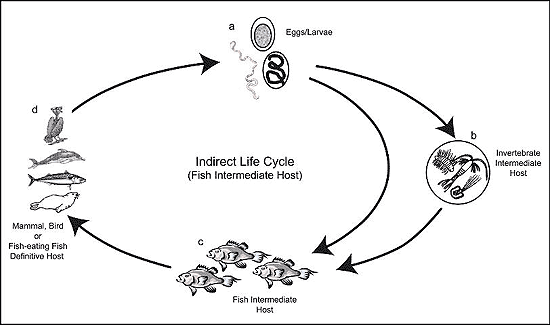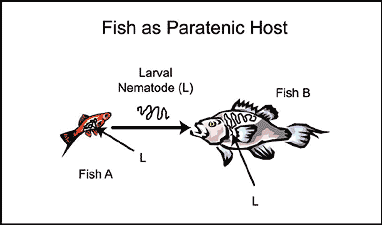

 |
||||||||||||
 |
||||||||||||
| Nematode (Roundworm) Infections in Fish | ||||||
| Page 4 of 11 | Pages: 1 . 2 . 3 . 4 . 5 . 6 . 7 . 8 . 9 . 10 . 11 | |||||

Figure 8: Indirect life cycle where the fish is an intermediate host. The nematode eggs/larvae (a) enter an invertebrate intermediate host (b) OR a fish intermediate host (c) prior to being eaten by or entering the final host, a fish-eating mammal, bird, or fish (d). Some nematodes have the ability to survive in "alternative" organisms, known as "paratenic" hosts. These hosts are not required for completion of the life cycle but they can contain infective nematode life stages and be a source of infection ( Figure 9 ). They can be fish, worms or other aquatic organisms that eat the nematode eggs or larvae.  Figure 9: Paratenic host. Fish A contains a larval nematode (L). When Fish A is eaten by Fish B, larval nematode (L) migrates out of Fish A into Fish B's body. Fish B can be considered a paratenic host because it is not required for completion of the nematode life cycle, but can still serve as a host.
Figure 9: Paratenic host. Fish A contains a larval nematode (L). When Fish A is eaten by Fish B, larval nematode (L) migrates out of Fish A into Fish B's body. Fish B can be considered a paratenic host because it is not required for completion of the nematode life cycle, but can still serve as a host.
more ... |
 |
|||||
| About Us :: Message Board :: Chat | |||||
| Library :: Photo Gallery :: Links & Resources :: Breeders & Sponsors :: Merchandise | |||||
| Website designed by: EthanCote.com | © 2001-2004, SimplyDiscus.com. All Rights Reserved. | ||||